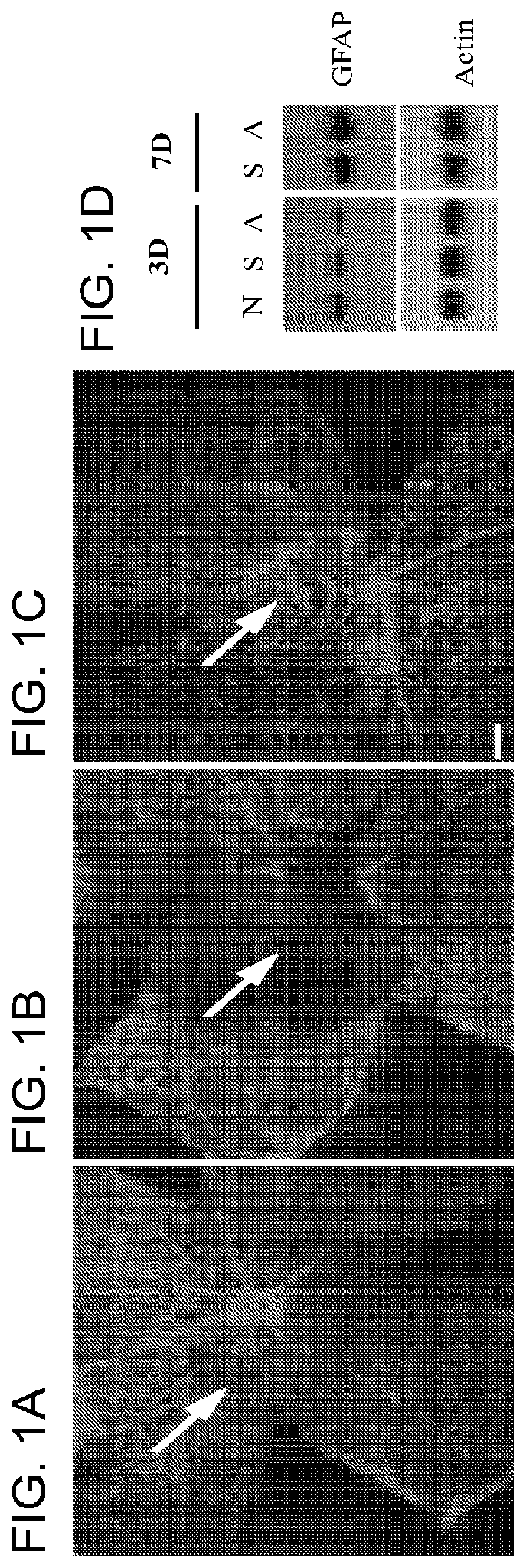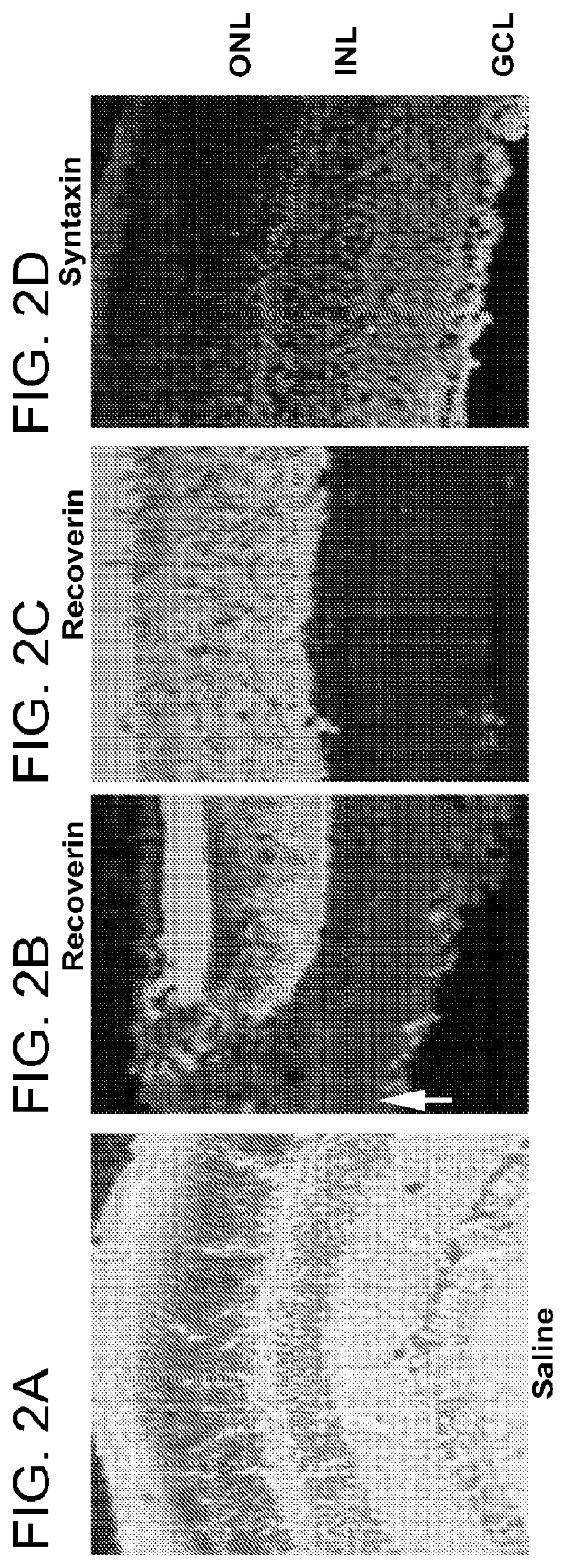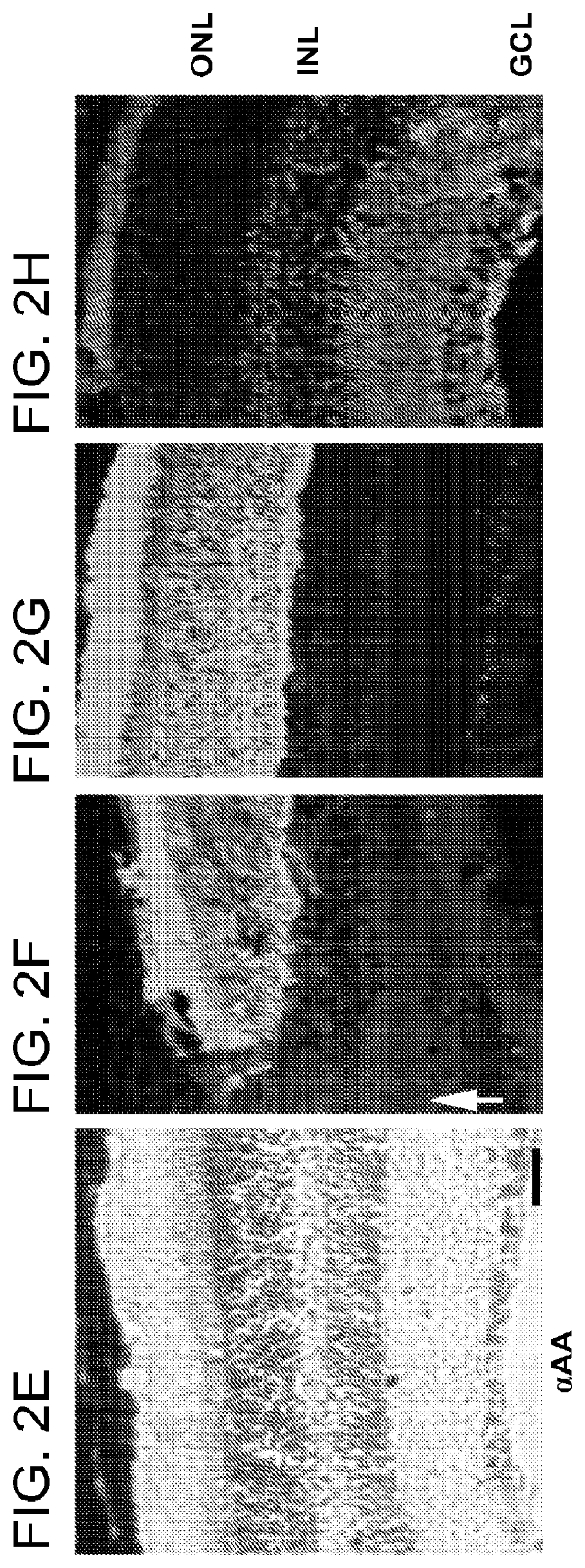Alpha-aminoadipate for treatment of vision loss and restoring sight
a technology of alpha-aminoadipate and vision loss, applied in the field of ophthalmology, can solve the problems of inability to address lost or degenerated cells, no treatment that stimulates the retina to regenerate new cells endogenously, and challenges and technical hurdles, and achieves the effect of increasing or restoring the activity/function of the photoreceptor and restoring vision
- Summary
- Abstract
- Description
- Claims
- Application Information
AI Technical Summary
Benefits of technology
Problems solved by technology
Method used
Image
Examples
example 1
Disruption of Retinal Glial Structure by α-AA
[0099]Retinal astrocytes and Müller glia are central to the homeostatic and metabolic support of retinal neurons; whereas, after injury these cells develop glial scar that forms critical barriers to neuron regeneration and integration by retinal progenitor cells. A solution of α-AA (1 μg / μl) was injected into the subretinal space of adult wild-type mice. Retinal glial morphology was examined by immunolabeling for glial marker GFAP and assessed the level of GFAP expression by Western blot at day 1-7 post injection. Expression of GFAP is widely detected in the normal mouse retinas (FIG. 1a). A single administration of α-AA effectively eliminated GFAP expression around the injection site at 1-3 days post injection (FIG. 1b), indicating the disruption of the glial barrier structure which may lead to the permissive environment for neuron regeneration and integration by retinal progenitor cells. By day 7, however, GFAP immunostaining reappeared...
example 2
afted Cell Integration into α-AA-treated Host Retinas
[0101]If transient disruption of retinal glia with α-AA promotes morphological integration of grafted retinal progenitors in vivo was next investigated. To distinguish implanted cells from the host environment, retinal progenitor cells were isolated as previously described using P0 mouse pups expressing an enhanced green fluorescent protein (EGFP) transgene driven by a chicken β-actin promoter and cytomegalovirus enhancer. At day 2 following saline or α-AA subretinal injection, retinal cells from P0 EGFP mice were injected into the subretinal space of adult wild-type hosts. Three weeks post transplantation, most donor-derived progenitor cells remained at the injection site and failed to migrate or incorporate into the host retina of the untreated or saline-injected wild-type mice (FIG. 3). In contrast, in α-AA-treated mice, numerous grafted cells had migrated away from the injection site and spread widely into the host retinas. Th...
example 3
iation of Transplanted Retinal Progenitors in α-AA-Treated Host Retinas
[0102]To determine whether α-AA-treated retina presents a supportive environment that allows appropriate differentiation of retinal progenitors, the behavior of transplanted cells was studied. The fate of transplanted cells was tracked using immunohistochemistry. At day 1 post transplantation, most EGFP+ cells clustered around the injection site and expressed a progenitor cell marker nestin (FIG. 4a-c). By 21 days post transplantation, grafted cells had integrated into the host, and became positive for mature glial cell marker, GFAP (FIG. 4d-g), or neuronal markers, Brn-3b (retinal ganglion cells; FIG. 4h-k) and PCKα (bipolar cells). Many of these cells were localized to the appropriate retinal layers where their corresponding host cells resided. Subretinal injection of α-AA resulted in the majority of grafted cells integrating into the outer nuclear layer (ONL) and expressed the mature photoreceptor cell markers...
PUM
| Property | Measurement | Unit |
|---|---|---|
| time | aaaaa | aaaaa |
| pH | aaaaa | aaaaa |
| intraocular pressure | aaaaa | aaaaa |
Abstract
Description
Claims
Application Information
 Login to View More
Login to View More - R&D
- Intellectual Property
- Life Sciences
- Materials
- Tech Scout
- Unparalleled Data Quality
- Higher Quality Content
- 60% Fewer Hallucinations
Browse by: Latest US Patents, China's latest patents, Technical Efficacy Thesaurus, Application Domain, Technology Topic, Popular Technical Reports.
© 2025 PatSnap. All rights reserved.Legal|Privacy policy|Modern Slavery Act Transparency Statement|Sitemap|About US| Contact US: help@patsnap.com



